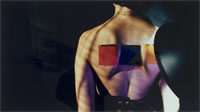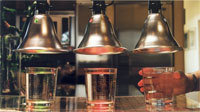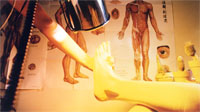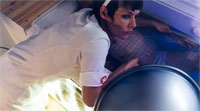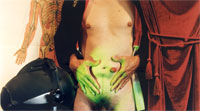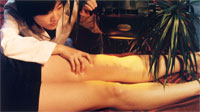Patrick Nagatani
Chromatherapy
March 30 - May 14 , 2001
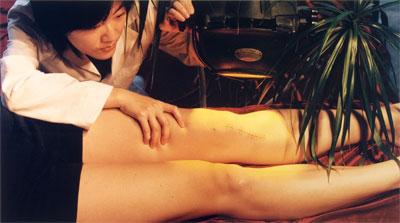 Dr. Ting, ACL, Meaghan (ACL Reconstruction) [ Model: Ting Xu ] , 2005 |
"I am interested in making images that theatrically depict colored light healing and stated in frank terms, I am interested in creating cinematic narrative images that are medical charades of Chromatherapy." - Patrick Nagatani
Andrew Smith Gallery of Santa Fe, New Mexico is bringing Patrick Nagatani's spectacularly colored cinematic narrative, Chromatherapy, to the AIPAD New York Photography Fair in February 2006 and to Santa Fe in March 2006. Chromatherapy is the latest body of constructed photographs by Patrick Nagatani, one the founding artists of photography's Contemporary Constructive Movement. The exhibition will be previewed at the AIPAD Fair February 9 - 12, 2006. In March 2006 it will be installed at the Andrew Smith Gallery in Santa Fe, New Mexico. The Chromatherapy project, begun in 1978 while Nagatani was still living in Los Angeles, has occupied the artist in between other large projects for the past twenty-five years. The series of color photographs relate to the subject of chromatherapy, or "color healing." With roots in ancient Egypt and China, chromatherapy involves the belief that shining the rays from colored lamps on afflicted areas can cure diseased organs of the body. In contrast to conventional medicine's often aggressive, drug-oriented methods, chromatherapy offers a gentle, noninvasive cure for all kinds of illnesses. Reminding viewers that light is the basic tool of photography, Nagatani creates real and imaginary relationships between photography, light and healing, as he photographs persons, animals and objects being exposed to a variety of colored lights. The artist is also exploring popular culture's fascination with growth and healing, teasing the fine line between a staged fiction masking as a documented reality, and the undeniable need humans have to embrace magic and pagan rituals for their own sake. Along with tableaux artists Thomas Demand, Gregory Crewdson and Sandy Skoglund, Nagatani pioneered the Contemporary Constructive Movement in the late 1970s. He has been highly influential in developing a vocabulary of ideas and presentation based on constructing large scale sculptures, small models, and paintings in front of the camera. Nagatani controls the scene by manipulating the camera's narrow depth of field with forced perspective, a filmmaking technique used to create optical illusions such as making objects appear smaller or larger, or appear far away when set space is limited. Having built and then photographed his sets, Nagatani prints the images as Polaroid, Cibachrome or Ilfoflex photographs before destroying the sets. Nagatani's protean creativity is matched by an intellectual grasp about serious issues and events that comprise and threaten contemporary society. Over several decades he has explored such subjects as the nuclear waste industry, anachronistic archeology, prisoner of war camps, and apocalyptic disasters of all kinds. The theatrical dimension of his works reflects his experiences in the Hollywood film industry in the 1970s. The vivid nightmare scenarios he portrays are safely contained within the boundaries of the photographs, the horror of each event mitigated by dashes of slapstick or macabre humor, and fantastic displays of color and imagination. His work has been described as tableau vivant on an operatic scale. Nagatani learned state-of-the-arts filmmaking and model building techniques when he worked for several major movie companies in Hollywood in the 1970s. His work for sci-fi movies made by Steven Speilberg and George Lucas included building models of the futuristic architecture in the film Bladerunner, and the mother ship in Close Encounters of the Third Kind. Nagatani's Hollywood experiences are the basis for the directorial mode he assumes when arranging people and props in front of his camera to fabricate his images. Many people genuinely believe that color has a tangible effect on mental and emotional states. Chromatherapy is widely practiced in India as an Ayurveda healing technique, while in the West it is being incorporated in high-end spa and bath designs. Nagatani's Chromatherapy series is filled with enough magic realism to encourage viewers to suspend disbelief and entertain the idea that there actually exists a wonderful, non-invasive alternative to surgery and drugs. Nagatani's photographs encourage us to believe that curing serious illness may be no more stressful than taking a warm bath.
Nagatani has written, "All light is visible radiant energy and travels through space in forms of waves. As it travels, it also vibrates. Colors, light, and heat are thus related to wavelengths. These waves very in length and the individual variations are the bases of each color."
"In the Middle Ages," writes Nagatani," the great cathedrals of Europe had stained glass windows which were used in healing. When the ill were placed in the light from the windows many miraculous cures were recorded."
Nagatani, who always sees two sides of the coin, balances chromatherapy's positivistic fantasy of healing with a sinister dimension. Twisting the subject in on itself, chromatherapy can also be seen as an exotic hoax. In some images the intense colored lights, chrome equipment, sterile tile surfaces, and tubular devices have a clinical coldness that conjures up uneasy ideas of the "doctor as god." This is the shadow side of any medical approach disconnected from real compassion that intrudes mercilessly, less interested in the patient's needs and limitations than in test results and financial gain. In a composition flooded with yellow light titled Singularity, 1978/2004 a hand holds an outstretched foot with a
The photographs in Chromatherapy are printed by Nagatani on Ilfoflex 2000 paper. The prism-like colors he achieves are as much the content of the works as the subjects described. Electric blues, hot yellows, poisonous greens, and theatrical purples flow over these prints. Nagatani has spent his lifetime translating his thoughts into color images. For him color is language.
Born in Chicago in 1945 to Japanese-American parents Nagatani moved with his family to Los Angeles. As a child he loved making models, a passion that served him later when he built models for Hollywood sci-fi films. He taught photography at colleges in the Los Angeles area. At UCLA Nagatani studied with photographer Robert Heineken who inspired him to construct his own large scale photographic tableaux in front of the camera. Collaborating with the artist Andree Tracey who provided painted portions of the imagery, Nagatani's images from this period portrayed an somnambulistic consumer society living on the edge of obliteration from various disasters: earthquakes, tidal waves, subway crashes, AIDS, and nuclear holocaust. Nagatani arrived in Albuquerque in 1987 to teach photography at the University of New Mexico. He quickly discerned that the state's nuclear industry was the underbelly of the so-called "Land of Enchantment," and he researched the subject for two years in preparation for his mammoth work, "Nuclear Enchantment" (1991). Using the same creative blend of photography, sculpture, and painting he had developed in Los Angeles, Nagatani built and photographed panoramas, eventually creating forty images, a limited edition portfolio, and a book published by UNM Press. In the next decade Nagatani produced other comprehensive projects. In the "Japanese-American Concentration Camps" (1995) series he photographically documented what remains of many Japanese internment camps erected in the western United States during World War II. In "Evacuations" (2001) he pushed the "malleable picture space" of the photograph, borrowing techniques from archeological fieldwork to explore ways in which photography creates, recreates, or supports a particular history. Current projects include "Taped Pieces" and "Chromatherapy." Currently Nagatani is working on various projects in his multi-room studio close to the University of New Mexico. He is recovering from a recent bout with cancer, though this has scarcely diminished his tireless creative energy. He was on medical leave from the UNM art department where he has taught for twenty years, but has resumed teaching in 2006. Nagatani's work is in over fifty important public collections nationally and internationally. He has received numerous awards and grants including two major National Endowment for the Arts Visual Artist Grants. Liz Kay |
